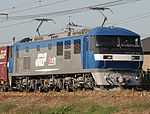JR Freight Class EH500
| Class EH500 | |
|---|---|
|
EH500-31 at Koriyama Rolling Stock Centre, August 2010 | |
| Type and origin | |
| Power type | Electric |
| Builder | Toshiba |
| Build date | 1997– |
| Specifications | |
| UIC classification | Bo'Bo'+Bo'Bo' |
| Gauge | 1,067 mm (3 ft 6 in) |
| Length | 25,000 mm (82 ft 0 in) |
| Width | 2,950 mm (9 ft 8 in) |
| Height | 3,917 mm (12 ft 10.2 in) |
| Locomotive weight | 134.2 t |
| Electric system(s) | 1,500 V DC & 20 kV (50/60 Hz) AC |
| Traction motors | AC |
| Performance figures | |
| Maximum speed | 110 km/h (70 mph) |
| Power output | 4 MW (5,400 hp) |
| Tractive effort | 24,551 kgf (240,760 N; 54,130 lbf) |
| Safety systems | ATS-SF |
| Career | |
| Operator(s) | JR Freight |
| Number in class | 82+ |
| Delivered | September 1997 |
| Disposition | Still in production |
The Class EH500 (EH500形) is a Bo'Bo'+Bo'Bo' wheel arrangement multi-system AC/DC two-unit electric locomotive type operated by JR Freight in Japan since 1997.[1][2]
Operations
The locomotives are built at the Toshiba factory in Fuchū, Tokyo. Initially, they were all based at Sendai depot for use on long-distance container trains from the Tokyo area to Hokkaido via the Tohoku Main Line, replacing DC Class EF65s south of Kuroiso, pairs of AC Class ED75s north of Kuroiso, and pairs of AC Class ED79s through the Seikan Tunnel.[1]
In 2004, locomotives EH500-25 and EH500-27 were loaned in turn to Moji depot in Kitakyushu for trials. From 2007, a number of EH500s were transferred to Moji depot for use on 1,300 tonne freight trains between Honshu and Kyushu through the Kanmon Tunnel, replacing ageing AC Class ED76s and dual-voltage EF81-300s and EF81-400s.
As of 2013, the fleet totalled 82 locomotives (EH500-901 and EH500-1 to EH500-81).[1] Locomotives EH500-45 to EH500-50 are based at Moji Depot, and all other members of the class are based at Sendai.[3]
Variants
- EH500-901: Prototype
- EH500-1 – 2: Pre-series 1st batch
- EH500-3 – 9: Full-production 2nd batch
- EH500-10 –: 3rd batch
EH500-901
The prototype, EH500-901, was delivered to Sendai depot in September 1997 for extensive testing on the Tohoku Main Line and Kaikyo Line until March 1999.[2] The livery is red and grey with black cab surrounds.[2] It joined the rest of the Class EH500 fleet for use on revenue services from the start of the March 2000 timetable revision.[2] "Kintaro Eco-Power" logos were added to the sides from December 2002.[2]
-
Prototype EH500-901, August 2010
1st batch: EH500-1 and EH500-2
Two pre-series locomotives, EH500-1 and EH500-2, were delivered in March 2000.[2] These locomotives are finished in a livery of maroon and grey with black cab surrounds.[2]
-

EH500-2, August 2011
2nd batch: EH500-3 to EH500-9
Built from March 2000 to January 2001. The headlamps were moved to a higher position to reduce problems of blockage by snow.[1] New "Kintaro Eco-Power" logos were added to the sides.
-

EH500-4, April 2012
-

EH500-5, March 2007
-
Inner end of EH500-3 undergoing overhaul, May 2007
3rd batch: EH500-10 onward
Locomotives from EH500-10 (delivered in August 2001) onward are painted in a revised colour scheme using bright red instead of the earlier maroon colour. The black colour around the cab windows was also discontinued.[1] Locomotives numbered EH500-15 onwards have narrower surrounds on the front-end headlight boxes, and the front-end white band is also correspondingly slightly thinner.[1]
-
EH500-12, March 2003
-
EH500-43, October 2010
-

Newly delivered EH500-68, June 2010
-
EH500-38 in December 2011 with a "Cheer up Tohoku!" sticker added after the 2011 Tohoku earthquake
See also
References
| Wikimedia Commons has media related to JR Freight EH500. |
- ↑ 1.0 1.1 1.2 1.3 1.4 1.5 JR機関車カタログ [JR Locomotive Catalogue]. Japan: Ikaros Publications Ltd. 20 June 2013. pp. 72–74. ISBN 9784863207271.
- ↑ 2.0 2.1 2.2 2.3 2.4 2.5 2.6 JR全車輌ハンドブック2009 [JR Rolling Stock Handbook 2009]. Japan: Neko Publishing. 2009. pp. 53–54. ISBN 978-4-7770-0836-0.
- ↑ JR気動車客車編成表 2013 [JR DMU & Coaching Stock Formations - 2013]. Japan: Kotsu Shimbunsha. 30 June 2013. p. 144. ISBN 978-4-330-37813-8.
| ||||||||||||||||






